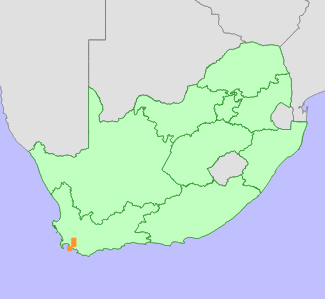|
Scientific Name | Aspalathus monosperma (DC.) R.Dahlgren |
Higher Classification | Dicotyledons |
Family | FABACEAE |
Synonyms | Borbonia monosperma DC. |
National Status |
Status and Criteria | Rare |
Assessment Date | 2009/07/14 |
Assessor(s) | D.A. Kamundi & L. von Staden |
Justification | EOO 482 km², a rare, range-restricted habitat specialist that occurs in montane habitat where it is not threatened. |
Distribution |
Endemism | South African endemic |
Provincial distribution | Western Cape |
Range | Hottentots Holland Mountains to Palmiet River Mountain. |
Habitat and Ecology |
Major system | Terrestrial |
Major habitats | Kogelberg Sandstone Fynbos |
Description | Montane fynbos, marshy slopes and stream sides. |
Population |
A reseeder which can be very common after fires.
|
Population trend | Stable |
Assessment History |
Taxon assessed |
Status and Criteria |
Citation/Red List version | | Aspalathus monosperma (DC.) R.Dahlgren | Least Concern | Raimondo et al. (2009) | |
Bibliography |
Dahlgren, R. 1968. Revision of the genus Aspalathus. III. The species with flat and simple leaves. Opera Botanica 22:7-126.
Dahlgren, R. 1988. Crotalarieae (Aspalathus). In: O.A. Leistner (ed). Flora of southern Africa 16 Fabaceae, Part 3 Papilionoideae, Fascicle 6:1-430. National Botanical Institute, Pretoria.
Goldblatt, P. and Manning, J.C. 2000. Cape Plants: A conspectus of the Cape Flora of South Africa. Strelitzia 9. National Botanical Institute, Cape Town.
Raimondo, D., von Staden, L., Foden, W., Victor, J.E., Helme, N.A., Turner, R.C., Kamundi, D.A. and Manyama, P.A. 2009. Red List of South African Plants. Strelitzia 25. South African National Biodiversity Institute, Pretoria.
|
Citation |
| Kamundi, D.A. & von Staden, L. 2009. Aspalathus monosperma (DC.) R.Dahlgren. National Assessment: Red List of South African Plants version 2024.1. Accessed on 2025/10/26 |
 Comment on this assessment
Comment on this assessment


